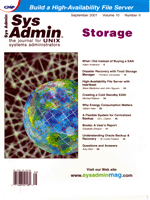 Books:
A User's Report Books:
A User's Report
Elizabeth Zinkann
This month's selections vary from shell programming to administration
to a Web server reference. Specifically, they include: The Korn
Shell: Unix and Linux Programming Manual, Third Edition by Anatole
Olczak (Addison-Wesley); Tru64 UNIX File Administration Handbook
by Steven M. Hancock (Digital Press); Linux for Windows NT/2000
Administrators by Mark Minasi with Dan York and Craig Hunt (Sybex);
and Apache Desktop Reference by Ralf S. Engelschall, Foreword
by Roy T. Fielding (Addison-Wesley).
The Korn Shell: Unix and Linux Programming Manual
Third Edition
Anatole Olczak
Addison-Wesley
ISBN-0-201-67523-4
446 Pages
$44.95
CD-ROM Included
http://www.aw.com/cseng
http:// www.informit.col.com
One of my favorite aspects of UNIX systems administration is shell
programming. According to a recent issue of Sys Admin, many
readers share this interest with me. Whether it is an affinity for
the programming itself, or for the streamlined procedures it creates,
the advantages of the shell are well worth learning. In the Third
Edition of this Korn shell programming manual, Olczak has updated
the text to reflect changes in "Korn Shell 93". He presents
the basic ksh commands and interface, demonstrates how to
program shell scripts, and includes coverage of pdksh for
Linux.
The first chapter introduces Korn shell and describes where to
get it and how to access it, both automatically and from the command
line. In the succeeding chapters, Olczak addresses Korn Shell Basics,
Variables and Parameters, Editing Commands, Job Control, Performing
Arithmetic, The Environment, Writing Korn Shell Scripts, and Miscellaneous
Commands. The Appendices contain A) Sample .profile File; B) Sample
Environment File; C) C Shell Functionality; D) Sample Korn Shell
Scripts; E) Korn Shell Man Page; F) Pdksh; G) Pdksh Quick Reference;
and H) Pdksh Man Page. The Accompanying CD-ROM includes a .pdf file
of the book, a 90-day evaluation copy of U/Win (which provides a
ksh-like environment within a Windows 9x/NT system), an upgrade
to U/Win, pdksh (the public domain version of the Korn shell,
frequently used on Linux systems), and an informative text file.
The Korn shell is a versatile utility; it provides an interface
to the operating system, a scripting and programming tool, and command-line
editing capabilities. Olczak effectively describes each of its features,
presenting each concept with any applicable options, variables,
operators, or examples in a straightforward and well-written style.
The inclusion of the ksh and pdksh man pages (as well
as the pdksh quick reference) furnishes a valuable resource
for the user. Olczak's superb approach and explanations coupled
with the software and Adobe Acrobat version of the book make The
Korn Shell: UNIX and Linux Programming Manual, Third Edition,
an excellent resource. This is an ideal choice for anyone learning
ksh, upgrading to the Korn Shell 93 Standard, or simply wishing
to know more about shell programming in general.
Tru64 UNIX File Administration Handbook
Steven M. Hancock
Digital Press
ISBN 1-55558-227-3
533 Pages
$36.95
http://www.bh.com/digitalpress/
Each variant of the UNIX operating system has some of its own
unique terminology (i.e., HP-UX's SAM versus AIX's SMIT).
In some cases, administration procedures may also differ slightly.
The Compaq Tru64 UNIX system (a.k.a. Digital UNIX) is an excellent
example of this trend. In the Tru64 UNIX File System Administration
Handbook, author Steven Hancock, who is also a Compaq Tru64
UNIX support engineer, explains the processes that this system utilizes,
emphasizes the concepts administrators need to know, demonstrates
how the Tru64 UNIX file system works, and discusses some of the
advanced techniques implemented by Compaq's TruCluster.
Each chapter begins with an introduction, presents several major
concepts or practices, and ends with a summary and notes. Each concept
is further divided into smaller sections. For example, UNIX File
Types contains Regular Files; Directories; Symbolic Links; Device
Special Files; Named Pipes; and Local Sockets. The individual sections
contain a description and an example, when applicable. Hancock begins
the book with a preface and Introduction, which outlines the definitions
and terminology as well as some UNIX commands and UNIX File Types.
The following chapters examine: Storage and Device Management; Logical
Storage Manager; Tru64 UNIX File Systems Architecture; UNIX File
System; Advanced File System: The Basics; Advanced File System:
Advanced Topics; File Systems Configuration and Tuning; and File
System Troubleshooting and Recovery. The Appendices contain A) Freeware
Tools; B) Advanced AdvFS Commands; C) The fsck(8) Command
Operation; and a Glossary.
A recurring theme of the book discusses storage, backup, and recovery
of large amounts of data or hard drives -- one of the purposes
of the Advanced File System, which was specifically designed for
64-bit file systems. Tru64 UNIX File System Administration Handbook
is an exceptional addition to existing UNIX/Linux systems administration
references. Steven Hancock takes the time to thoroughly explain
what you need to effectively administer a Tru64 UNIX system and
why you need it. He also addresses some problems facing the Tru64
UNIX administrator (and UNIX administrators in general) and the
best ways to solve them. This is a superb book on a topic seldom
addressed for administrators.
Linux for Windows NT/2000 Administrators
Mark Minasi with Dan York and Craig Hunt
Sybex
ISBN 0-7821-2730-4
526 Pages
$39.99
CD-ROM Included
http://www.sybex.com/
http://www.lpi.org/
The most effective way to explain anything starts with a common
denominator. It's important to describe it in terms that both
sides understand. Finding that shared vocabulary is the most challenging
part of the process. It is particularly difficult when the other
person understands the underlying concepts, although not in the
same language. This is the essential problem facing Windows NT or
Windows 2000 administrators trying to learn Linux. They are familiar
with many of the procedures, but not the individual commands that
Linux uses.
Minasi, York, and Hunt solve this problem by demonstrating where
Linux procedures differ from the Windows NT/2000 techniques and
by showing how Linux handles the same tasks that NT and 2000 can
also achieve. After Minasi's Overview, the authors address
the following topics: Why Learn About Linux?; What's in It
for Me?; What Do People Do with Linux?; How the Linux World Operates;
Getting Linux on Your System; Linux Hands-On: Doing Basic Things
with Linux; User Accounts and File Permissions; Desktop Linux: Handling
Graphics and GUI Applications; Setting Up Linux's Server Services;
Linux/Microsoft OS Interoperability; and Conclusions: Linux versus
Microsoft, Linux and Microsoft. The Appendix lists various types
of Linux resources. The accompanying CD-ROM includes Linux-Mandrake
7.1 plus additional server and workstation applications.
The amount of information contained in this book is amazing. The
authors not only delve into installation procedures, basic Linux
commands, installing new applications, and recompiling the kernel,
but they also present some of the history, the essence of Open Source,
plus how to use DNS, Apache, and FTP, to mention just a few of the
topics.
Linux for Windows NT/2000 Administrators (subtitled The
Secret Decoder Ring) is an extremely well-written book. Minasi,
York, and Hunt address the essential topics in a clear, straightforward
manner, utilizing numerous examples. This is a helpful book for
any administrator who needs to learn Linux or for a Linux administrator
faced with the task of integrating systems. Linux for Windows
NT/2000 Administrators will provide an excellent reference for
any administration library.
Apache Desktop Reference
Ralf S. Engelschall
Apache Software Foundation
Foreword by Roy T. Fielding
Addison-Wesley
ISBN 0-201-60470-1
184 Pages
$39.95
http://www.awl.com/cseng/
http://www.apacheref.com/
The Apache Web Server is unsurpassed in its popularity and reliability.
Anyone who installs, configures, or troubleshoots Apache installations
and configurations will discover that Engelschall's book an
indispensable tool. My initial reaction to this book is that I wished
I had it when I first installed Apache. However, Engelschall included
more than the configuration directives within this slim volume.
He begins with an Introduction that includes its history plus a
description of the Apache Group. Succeeding chapters explore Apache
Functionality; Building Apache; Configuring Apache; Running Apache;
and Apache Resources. Ideally, after reading this, you will know
its history and architecture, how to build and install it, how to
configure any and every directive and module, and where to look
for the most current references. Realistically, you will know where
to look to find all of the above information.
The Apache Desktop Reference is a superbly written and
well-organized book. The reader will know exactly where to look
for a specific topic, module, or directive without assistance from
the Index or Table of Contents. Engelschall's side notes are
humorous, informative, and insightful. If you are in charge of maintaining
an Apache configuration, or want to set one up, get this book! It
is an extraordinary guide to the Apache Web Server and the essential
instruction manual to any Apache configuration.
Elizabeth Zinkann has been involved in the UNIX and C environment
for the past 15 years. She is currently a UNIX and C consultant,
and one of her specialties is UNIX education. In addition to her
computer science background, she also has a degree in English. Her
writing has also appeared in Linux Magazine, Performance
Computing, and Network Administrator. Elizabeth can be
reached at: elizabeth@equillink.com.
|

